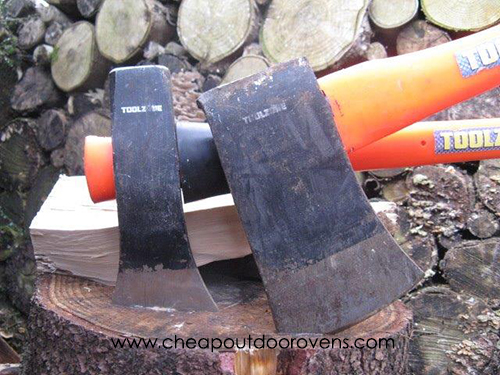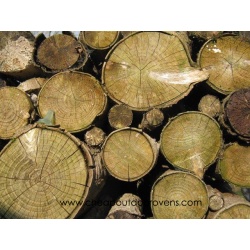Choosing and sourcing your firewood
As you will probably know, there are a whole forest worth of tree species to choose from to fuel a fire. Many of which burn in different ways, for example some burn fast and with more flame and little heat output where as others will burn slowly with little flame and more heat (the latter being the most ideal). But there are a select group which are best to use in your oven. Most pointers below are pretty self explanatory, but we may have customers that are new to cooking using wood. We hope we have covered most of what you need to consider when getting started.
We recommend you use only seasoned (very dry) Hardwood with low smoke and a steady burn in your oven. The best and most used wood to burn in your oven is oak, maple, ash, beech and birch. Also fruit trees, apple, cherry, pear. Fruit tree wood not only burns well, they are also fragrant. A lot of wood-fired pizzerias swear by apple.
If your wood is not properly seasoned you will find it hard to light your fire. Once going it will be hard to reach a good temperature for your oven to work efficiently. This is due to the heat created will be used to evaporate the water content contained in the green wood.
Steer clear of softwood, such as Cedar, Fir, Larch, Pine and Spruce. This is because of the high sap or oil content within the wood. These species of wood can release unpleasant, bitter flavours into the food and produce too much smoke which will leave soot deposits inside the oven and in your chimney if you have one.
You can burn construction off cuts from 2x4s or even broken up pallets for kindling to start your fire. It is a most important to NEVER burn laminated woods such as plywood, pressure treated woods, or anything that has been painted, chemically treated or glued.
You might want to consider using 'eco' type of logs and briquettes because they are very dry and dense. They are a blend of kiln dried untreated compressed timber briquettes that have been mechanically compressed to form a solid log. They is made by mixing a hot blend of wood sawdust/chips from Cedar, Oak, Pine and Beech wood to extremely high pressure and temperature. The natural resins in the wood softens, allowing the particles bind together to form a solid wooden log.
'Eco' type logs and briquettes are a relatively new product that manufacturers say can be safely used as a concentrated fuel source in all open fireplaces, log burners, wood fires and braziers. As there are no chemicals additives or binders used to hold the logs together, they can also be used as BBQ and Pizza Oven fuel. Just make sure the brand you use say you can use them as BBQ and Pizza Oven fuel as some may only be for stoves. We use them with our normal logs to help boost and prolong the heat in our ovens, especially for pizzas.
Cutting your own wood:

When cutting your own wood try to do it in the off-season, when the sap is in the roots. This is generally in late Autumn/Winter. Cut the tree or branches into rounds the right height to fit through the oven door and then split straight away into the desired size of logs. When buying your axe (if splitting by hand) make sure it is made for splitting! There are generally three types of axes to use. Firstly a felling axe, with a a long fan shaped blade. These are rarely used as there are far more quicker and exciting ways to drop a tree. Secondly the splitting axe. This will have a weighty lump hammer like end and a wedge like blade on the other. And thirdly, your trusty hand axe for kindling. You can pick up some very satisfying ones with great character from many antique shops and markets. Remember, split wood will always dry faster than larger pieces left in the round. Store your wood for about six months to a year to dry properly. You will know it’s ready when the cut ends have darkened and a series of "checks’ or cracks have appeared across the ends.
Failing all this palaver, you can just buy selected, split, dried and ready to go wood in a handy crate from our website. There are different sizes for you to choose from. You just need to make sure you stack sturdily and store it nice and dry.
Storing and seasoning your wood:
When storing your wood make sure it is in a well ventilated dry place. You can buy or build a log shed or you can just stack your logs and cover with a tarpaulin. Old pallets make good walls for logs sheds that let air through, not forgetting to ensure all the logs are off the ground.
Varieties of wood:
|
Type |
Description |
Score |
|
Apple |
A very good wood that bums slow and steady when dry, it has small flame size, and does not produce sparking or spitting. |
Good |
|
Ash |
Reckoned by many to be one of best woods for burning, it produces a steady flame and good heat output. It can be burnt when green but like all woods, it burns best when dry. |
Very good |
|
Beech |
Burns very much like ash, but does not burn well when green. |
Very good |
|
Birch |
Produces good heat output but it does burn quickly. It can be burnt unseasoned, however the sap can cause deposits to form in the flue with prolonged use. |
Good |
|
Cherry |
Is a slow to burn wood that produces a good heat output. Cherry needs to be seasoned well. |
Good |
|
Chestnut |
A poor burning wood that produces a small flame and poor heat output. |
Poor |
|
Elm |
Is a wood that can follow several burn patterns because of high moisture content, it should be dried for two years for best results. Elm is slow to get going and it may be necessary to use a better burning wood to start it off. Splitting of logs should be done early. |
Medium |
|
Hawthorn |
Is a good traditional firewood that has a slow burn with good heat output. |
Very good |
|
Hazel |
Is a good but fast burning wood and produces best results when allowed to season. |
Good |
|
Holly |
Is a fast burning wood that produces good flame but poor heat output. Holly will burn green, but best dried for a minimum of a year. |
Poor |
|
Hornbeam |
A good burning wood that burns similar to beech, slow burn with a good heat output. |
Good |
|
Laurel |
Burns with a good flame but only reasonable heat output. It needs to be well seasoned. |
Medium |
|
Lilac |
Its smaller branches are good to use as kindling, the wood itself burns well with a good flame. |
Good |
|
Maple |
Is a good burning wood that produces good flame and heat output. |
Good |
|
Oak |
Because of its density, oak produces a small flame and very slow burn, it is best when seasoned for a minimum of two years as it is a wood that requires time to season well. |
Good |
|
Pear |
Burns well with good heat output, however it does need to be seasoned well. |
Good |
|
Plum |
A good burning wood that produces good heat output. |
Good |
|
Rowan |
Is a good burning wood that has a slow burn with good heat output. |
Very good |
|
Sycamore |
Produces a good flame, but with only moderate heat output. Should only be used well-seasoned. |
Medium |
|
Thorn |
Is one of the best woods for burning. It produces a steady flame and very good heat output, and produces very little smoke. |
Very good |












